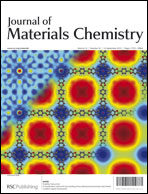Enhanced thermoelectric properties of CNT/PANI composite nanofibers by highly orienting the arrangement of polymer chains
Abstract
Carbon nanotube (CNT)/Polyaniline (PANI) thermoelectric composite nanofibers were prepared by a combination of in situ polymerization and electro-spinning processes. The obtained composite nanofibers were macroscopically aligned, while the CNTs were embedded in the nanofibers and oriented along the fiber axis. Polarized Raman spectra and X-ray diffraction (XRD) studies verified that the PANI backbone chains were orientated along the CNT axis and therefore along the fiber axis due to the strong chemical interactions between PANI and CNTs. The highly ordered arrangement of the PANI backbone chains not only reduces the π–π conjugated defects in the polymer backbone, but also increases the effective degree of electron delocalization and therefore enhances the carrier mobility in PANI, which results in the anisotropic thermoelectric properties especially with more than a doubled improvement of power factor in the orientation direction. This study not only provides an effective route to orient the conducting polymer chains at the molecular level but also demonstrates a possibility to design a conducting polymer with high thermoelectric performance through constructing a highly extended and orderly aligned backbone chain structure by chemical routes.


 Please wait while we load your content...
Please wait while we load your content...